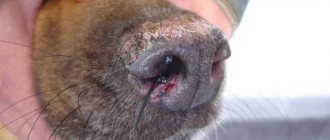Shar Peis are dogs that have a bright, original, memorable appearance and have gone through a difficult path of development and formation.
Each breed is characterized by some pathologies, Shar Pei are no exception - there are a number of diseases characteristic of representatives of this breed.
All owners of these dogs should be aware of the main signs of the development of the disease in their pets in order to be able to provide them with the necessary assistance and contact a veterinarian in time.
What diseases are they susceptible to?
Representatives of this breed are prone to developing the following diseases:
- fever is a hereditary disease manifested in swelling of the hock joints, a sharp increase in temperature and a number of other symptoms;
- hypothyroidism – a lack of thyroid hormones, leading to epilepsy, alopecia, obesity, hyperpigmentation, pyoderma and other pathologies;
- Elbow or hip dysplasia is a disease that causes your dog to develop weak joints, which can cause arthritis and lameness;
- demodicosis - infection with a skin parasite that causes redness, peeling of the skin, and baldness;
- pyoderma is a bacterial infection leading to the accumulation of pus in the outer layers of the skin;
- cutaneous mucinosis – production of too much mucin;
- luxation of the kneecap - displacement of the kneecap relative to the normal position;
- osteochondrosis – abnormal development of cartilage in the bursa;
- Gastric volvulus is a condition in which air trapped in the stomach due to the rapid absorption of large amounts of food stretches it;
- glaucoma – increased intraocular pressure.
A predisposition to a disease does not mean that a pet will necessarily have it..
Expert opinion
Kozhevin Semyon Kirillovich
Expert dog handler.
Any pathology without timely treatment will progress and can lead to serious consequences, including death. One of the most dangerous diseases in Shar-Peis is fever. Doctors still do not know the nature of this disease, and each stage is associated with significant risks. Considering the lack of possibility of a complete cure, the complexity of diagnosis and the manifestation of symptoms in later stages, most often the most humane treatment of the pet will be euthanasia.
Manifestations of the disease
A sick dog occasionally experiences bouts of fever, accompanied by a strong increase in temperature. The joints may swell and become very painful - the dog groans in pain and tries to move as little as possible.
The most common cause of fever is stress . This could be a show, a fight with a fellow breeder, a female dog in heat, or a meeting with an empty female dog for a male dog, fright, excessive physical exertion or another disease. Fever lasts from several tens of minutes to several days.
Main symptoms
Despite the differences in the clinical picture of various diseases, there are a number of signs that indicate that the Shar Pei has health problems:
- inflammation and redness of mucous membranes;
- the appearance of mucus and pus from the eyes, nose and ears;
- apathy, lack of activity;
- increased irritability, aggressive behavior;
- refusal to eat;
- shortness of breath, heavy breathing;
- itching;
- hair fragility and hair loss, local baldness;
- constipation or diarrhea;
- vomit;
- increase or decrease in temperature.
If one or more symptoms appear, you must immediately contact your veterinarian to make a diagnosis and prescribe the necessary treatment..
Gastrointestinal diseases
Sometimes while walking, dogs can pick up things from the road that will later cause them to be poisoned. Expired and stale food is no less dangerous. The main symptoms of poisoning: vomiting, diarrhea, fever, refusal to eat. To help the dog, you should give activated charcoal, or Smecta.
Congenital idiopathic megaesophagus most often occurs in puppies. Main symptoms: belching, delayed digestion due to dilation of the esophagus, increased salivation, difficulty swallowing food. The most effective is surgery.
Thus, the unusual appearance of Shar Peis has become the reason for their predisposition to certain diseases. A dog's skin needs special care, as it is prone to inflammation and infections. Due to the shape of the muzzle, the dog may have problems with the eyes, ears and breathing. Most health problems can be solved if you consult a doctor in time.
How long Shar-Peis live depends only on the care and responsibility of their owners.
Source fb.ru
Shar Peis adore people, they are especially loyal and gentle to their owners, showing love and friendliness towards them. It should be said that although Shar Peis are absolutely not aggressive, they are natural guards and even if there is a slight threat to family members, they will immediately come to the rescue and defend. If a difficult situation arises, the Shar Pei can make decisions independently, taking the initiative into its powerful paws.
The most common diseases that Shar Peis suffer from include systemic amyloidosis, entropy, pyoderma, and dermatomycosis.
Proper care, prevention of diseases and their reasonable treatment, skillfully composed diet will be the key to the longevity of your beloved dog. Shar Peis can live up to 10 years if they are loved, raised and cared for. To add strength and energy to your pet, pay attention to the products of the WOLMAR WINSOME company.
Fever in dogs
Fever is a hereditary autoinflammatory pathology that can cause the development of an incurable disease such as amyloidosis of internal organs.
It is believed that the disease develops as a result of a genetic mutation inherent in Shar Peis..
Because of it, protein molecules are polymerized and deposited in the tissues of internal organs. The kidneys are most at risk, but not all animals with fever are diagnosed with renal amyloidosis.
Symptoms and signs:
- swollen, inflamed paw joints;
- temperature increase to 39.4-41.6 °C;
- the appearance of deep ulcers on the mucous membrane of the mouth;
- dehydration;
- the appearance of an ammonia smell from the mouth;
- ascites;
- tachypnea;
- sudden paralysis of the hind legs;
- jaundice;
- polydipsia;
- polyuria;
- anorexia;
- vomit.
Unfortunately, at the initial stage the disease is asymptomatic; in only 25-43% of sick animals a large amount of protein is immediately detected in the urine.
CAREFULLY!
Symptoms appear at the age of 1-6 years, females get sick more often.
To diagnose fever, it is necessary to conduct a biopsy and cytological examination of the obtained material. If the clinical picture is very vague, a biopsy of the liver or other internal organs may be performed.
If the case is not advanced, replacement therapy is carried out: painkillers and non-steroidal anti-inflammatory drugs.
Treatment of fever is based on a drug that blocks excess synthesis of liver enzymes, which reduces the amount of amyloid and allows the Shar Pei to live longer and improve its quality.
The doctor also prescribes Clopidogrel to reduce red blood cell aggregation and eliminate the risk of thromboembolic disease and Amlodipine to combat arterial hypertension.
It is important to adhere to the correct diet prepared by a veterinary nutritionist.
- 1. Clinical manifestations
- 2. Pathogenesis of hereditary sharpei fever
- 3. Laboratory research
- 4. Treatment of NLS
- 5. Colchicine
- 6. Prevention of NLS
- 7. Control
- 8. Complications of NLS
- 9. Diagnosis of NLS
- 10. Future in the study of the problem of NLS
- 11. Recommendations for owners of Shar Peis with NLS
Hereditary Shar-Pei fever (FSF) is a genetic inflammatory disease found in this breed. This disease is transmitted through an autosomal recessive pathway. Those. In order for a Shar Pei to develop this disease, both parents must pass on recessive “diseased” genes to it.
Clinical manifestations of NLS
Episodic fever is the most striking and significant sign of the presence of this disease in Shar Pei. Fever manifests itself in an increase in temperature to 39.4 - 41.7 C, but in some cases a higher temperature is possible. It is “self-limiting” - it lasts 12-36 hours if an antipyretic is not given during this period of time. Another common symptom of FSF that accompanies a fever is swelling of the joints, most commonly the hocks (shin joints). This striking symptom of FSF is called swollen hock syndrome. The swelling is quite painful for the dog; the skin at the site of the swelling feels hot to the touch. In addition to (or instead of) the hocks, swelling may occur in the ankles, wrists, or lips. A dog with an attack of FSF behaves exactly like a sick dog - he moves reluctantly, his gait becomes awkward. This is often accompanied by abdominal pain, which causes the dog to arch his back.
Pathogenesis of hereditary sharpei fever
Here is what is currently known about NLS: 1. Shar-Peis with NLS have elevated levels of the cytokine interleukin-6 (IL-6). IL-6 is directly involved in the body’s “response” to fever and is an important part of the triggering mechanism for the liver’s production of C-reactive protein (one of the acute phase proteins, the number of which increases sharply during inflammatory processes in the body). IL-6 is also included in Systemic Inflammatory Response Syndrome (SIRS). Dysregulation of IL-6 levels is a direct consequence of FSF. IL-6 also plays a very important role in the body's stress response and serves as a fuel pump for the immune system. 2. Shar-Peis with FSF are at very high risk of early death from systemic amyloidosis. Approximately 25% of dogs with FSF develop renal amyloidosis, which leads to kidney failure. A small proportion of dogs with FSF develop hepatic amyloidosis. As a rule, amyloidosis of both forms occurs in Shar-Peis at 2-5 years of age. In addition, Shar Peis with FSF are more susceptible to immune-mediated kidney diseases, such as membranous glomerulonephritis and protein-dependent forms of glomerulopathy. These dogs are susceptible to forms of thromboembolism such as: mesenteric embolism, splenic embolism, pulmonary embolism. The rarest, but also the most devastating, consequence of FSF can be Streptococcal Toxic Shock Syndrome (STSS). 3. Shar-Pei hereditary fever has long been assumed to be the canine form of the human Hereditary Mediterranean Fever (FMF). Recent research suggests However, FSF is very similar to FMF 4. FSF is a familial genetic disorder that appears to be transmitted in an autosomal recessive manner.
Laboratory research:
Unfortunately, there are no blood tests, etc., that can determine FSF. During the episodes of fever themselves, blood tests may show: elevated levels of white blood cells (leukocytes); increased levels of liver enzymes and other non-specific changes. All attempts to study the DNA of sick dogs have also not yet yielded any results.
Treatment:
It is very important to constantly monitor the body temperature of a dog that has already had an attack of Shar-Pei fever. In a fever situation, when the temperature is elevated, aspirin is used to relieve it. The dog is given a full adult dose of aspirin every 6 hours for the first 24 hours after the onset of fever, and then twice daily for another 3-5 days. In rare cases where aspirin does not work, dipyrone is given for extremely high fevers. Some patients require supportive care during a fever in the form of intravenous fluids (drips), and in particularly severe cases, emergency care - exactly the same as for heatstroke. Antibiotics are not usually needed for Shar Pei fever.
Colchicine:
Colchicine is a human medicine prescribed to FMF patients to prevent the development of amyloidosis. We recommend it for Shar-Peis with FSF for the same purpose. There are still no official studies that fully prove the effectiveness of colchicine in Shar-Peis with FSF. However, clinical practice shows that it helps. Colchicine does not eliminate the likelihood of another attack of fever, but it smoothes its course and prevents the development of consequences. At this stage of research, side effects from taking colchicine appear to be minimal: they mainly relate to gastrointestinal disorders such as vomiting, diarrhea, anorexia (decreased appetite), etc.
Prevention:
Symptoms of Shar Pei fever appear only occasionally, sporadically. Fever occurs when the mechanisms that “trigger” it are turned on. One of the most powerful mechanisms is stress. A stressful situation can be anything - a training ground, an exhibition, a trip to the veterinarian, a female dog in heat (for a male), excessive exercise and stress, other illnesses, etc. If an owner can figure out these fever triggers and can protect their dog from them, the number of fever episodes will be greatly reduced. As far as diet is concerned, it does not appear to play any role in the prevention or development of Shar Pei fever and associated renal failure. Of course, diet is important for a dog with kidney failure, but no amount of nutrition will guarantee the prevention of kidney failure in a Shar Pei with hereditary fever. Low-dose aspirin therapy may help reduce the severity and frequency of fevers. Aspirin may also be useful in concomitant therapy to prevent thromboembolism.
Control:
Monitoring the complications that typically accompany FSF is one of the most important tasks for any owner of a dog who has had Shar-Pei fever at least once. The most common and consistent complication of hereditary Shar-Pei fever is renal failure due to immune-related renal disease or renal amyloidosis. I recommend urine tests every 3 months. The first morning urine is taken for analysis, provided that the dog last drank the night before. The first things I look at are indicators that measure urine concentration (color and density) and urine protein levels. When the kidneys begin to fail, the first sign is the loss of the ability to produce concentrated urine, and it becomes very light and its density decreases (signals of polyuria - increased excretion of water). These signs appear earlier than changes in renal parameters in biochemical blood tests occur. An increase in the need for water (increased thirst, the dog begins to drink more than usual), excessive urination - these are also clinical symptoms indicating that the dog’s kidneys are losing the ability to concentrate urine, but these first signs remain without any attention. I believe it would be reasonable to give each Shar Pei a complete blood and urine test every 6 months. And even more so, you need to do blood tests if urine tests show any abnormalities. It is also important to weigh the dog periodically, monitoring its weight, because... Weight loss is also a clinical symptom of the development of kidney problems. We often do not even notice a serious loss in a dog’s weight due to the fact that this loss is extended over time and, for this reason, is not noticeable. If your dog has already had a bout of Shar-Pei fever, closely monitor his appetite, weight fluctuations, and thirst. Increasing fluid intake with decreased appetite and weight loss are serious signals.
Complications of NLS:
In addition to the renal complications of NLS mentioned above, the following consequences of Shar-Pei fever are clinically documented: thromboembolism (mesenteric, splenic, pulmonary), disseminated intravascular coagulation (clotting) syndrome, systemic inflammatory response syndrome, multiple functional damage to internal organs syndrome (dysfunction) several vital organs at once), toxic streptococcal shock syndrome (the so-called “flesh-eating streptococcus”), increased blood pressure associated with renal failure. These complications are the leading cause of death in Shar-Peis following acute bouts of fever. No attack of Shar Pei fever should be treated superficially, simply by relieving the temperature and swelling!
Diagnosis of NLS:
Unfortunately, no special tests or analyzes have yet been invented that would allow diagnosing FSF. Diagnosis of FSF is based on the clinical manifestations of febrile episodes in Shar-Peis. I believe that every Shar Pei who dies should undergo an autopsy to determine the cause of death, but this is especially important if he has had bouts of FSF during his life. Renal amyloidosis can only be diagnosed based on a biopsy and tissue staining with Congo Red. This dye specifically reacts to the presence of deposited amyloid protein in tissues. Amyloid protein can also be found in the tissues of other organs of the Shar Pei, so request that all tissues taken for histopathological analysis be examined using this dye. Amyloid protein may not always be detected in tissue samples taken from dogs with FSF. However, this does not mean that amyloid protein is not deposited in these dogs; it only means that it is not present in the sample taken, or that it will begin to accumulate later. Further confusion in diagnosis comes from the fact that not all Shar-Peis with amyloidosis show signs of hereditary fever. In addition, bouts of fever can be so vague that they are mistaken for a normal increase in temperature or simply not paid attention to. Seizures can be very rare, they can occur in your absence, when the Shar-Pei is sitting at home alone or when he is fostered by a breeder, etc. All this makes diagnosis and timely control of the disease extremely difficult. This is sad, considering that such dogs may unknowingly be bred and produce the offspring of sick dogs or dogs carrying this genetic problem.
The future of NLS research:
The University of Michigan School of Veterinary Medicine has long been conducting research to develop a special DNA blood test that could be used to determine the presence of the pathological FSF gene in a particular Shar Pei. This project is led by Dr. Veterinarian Gary Johnson. Some time ago it was believed that Shar-Pei fever was an analogue of familial Mediterranean fever in humans, but research in this direction reached a dead end: the Mediterranean fever gene was identified in human DNA in 1997, after which futile attempts were made to identify a similar gene in Shar-Pei -peev. As it turned out, the gene mutations responsible for the inheritance of Mediterranean fever in humans are absent in dogs. This meant that despite the similarities in appearance and consequences, Shar-Pei fever and human fever were two different genetic diseases. There are also a number of genetic human inflammatory diseases, such as familial Irish fever, the mechanisms of which my colleague Linda Tintle suggests may be identical to FSF. Work to discover the gene mutations responsible for FSF is ongoing.
When the FSF test is finally completed, it will be possible to create a large-scale program to identify affected dogs, carrier dogs and genetically pure individuals. I believe that all kennels will have to have their dogs examined in order to gradually eliminate this genetic disease by selecting only healthy sires for breeding. One of the biggest challenges right now is the inability to even determine the phenotype of a dog affected by FSF. There is no specific age at which signs of FSF appear (the first attacks can begin after the dog is admitted for breeding), the clinical manifestations themselves can be very different, some dogs develop amyloidosis as a result of FSF, while others develop amyloidosis. No. All this makes genetic selection of Shar-Peis for FSF extremely difficult, since the method of identifying healthy and sick dogs by phenotype (external characteristics) very often does not work.
Recommendations for owners of Shar Peis with NLS:
All Shar-Peis with FSF must take colchicine for life and be regularly monitored with urine and blood tests for possible complications (primarily kidney complications). Dogs with FSF should never be used for breeding (it is best to have them neutered). Dogs whose parents or grandparents are affected by FSF should take colchicine and be screened with blood and urine tests. Dogs with FSF must be protected from any stress.
If this problem happened to your dog, print out this text and give it to your veterinarian to read.
This material was provided for translation and publication on this site by Doctor of Veterinary Medicine, President of the veterinary committee “The Health Through Education” of the American National Shar-Pei Club, practicing veterinarian Jeff Widt. Over the past 20 years, Dr. Widt has been one of the key figures in the study of hereditary diseases of Shar Pei in the United States. All personal statements contained in this article belong to its author; I have only translated this text, making it, if possible, a little clearer for ordinary readers. Sincerely, Elena Ivashchenko.
Gastrointestinal diseases
Shar Peis have a sensitive digestive system, so gastrointestinal problems are not uncommon for them.
Diarrhea
Diarrhea can be triggered by a change in diet, food allergies, helminthic infestation, or ingestion of inedible objects.
Treatment is based on diet, drinking plenty of fluids, and enemas with chamomile infusion. Medicines prescribed include Catozal, sorbents, and probiotics. .
Congenital megaesophagus
It appears in puppies immediately after the end of the lactation period. This disease is characterized by dilation of the esophagus, as a result of which the digestion process slows down, belching occurs, and salivation increases.
Surgery is recommended.
Lymphocytic-plasmacytic enteritis
Inflammation of the intestine, in which the basis of the cellular infiltrate of its mucosa is composed mainly of lymphocytes and plasma cells.
Shar Pei diseases and methods of their treatment
Shar Pei is one of the oldest dog breeds. These powerfully built, medium-sized animals with numerous folds of skin and a pigmented blue-black tongue are native to China, where they were first used as guards and hunters before being virtually exterminated. Today they are distributed throughout the world thanks to the campaign to revive the breed and its official registration that began in the seventies of the twentieth century. The calm nature and exotic appearance of these dogs has ensured their traditional popularity in Russia. However, like other dogs, they have a breed predisposition to a number of diseases, including diseases of the skin, eyes, gastrointestinal tract, respiratory and immune systems, kidneys and urinary tract.
A large number of skin folds contributes to friction trauma, diaper rash and inflammation, hypersecretion of the sebaceous glands, which creates a favorable environment for infection by bacterial and fungal microflora. An increase in the amount of mucin in skin folds leads to the manifestation of idiopathic mucinosis of the skin - a disease characterized by the appearance of edema, vesicles and bullae. The chronic course of dermatological diseases in Shar Peis can be caused by immune pathology - selective deficiency of immunoglobulin A. To diagnose skin diseases, you need to consult a veterinary dermatologist.
Generalized demodicosis. A parasitic disease caused by intradermal mites of the genus Demodex. Infection of animals occurs through contact. Clinical signs include itching, alopecia (bald areas throughout the body), and the appearance of papules. Demodicosis can lead to pyoderma and deep folliculitis.
Atopy. Atopy can be considered as a skin manifestation of an allergic reaction to foreign environmental proteins, including food components. Itching, redness, the appearance of pustules, and complications from a secondary bacterial infection may occur. The age of the patients ranges from 6 months to 7 years. Depending on the allergens causing the hypersensitivity reaction, the disease may be seasonal.
Primary seborrhea. A characteristic sign of seborrhea is flaky skin, covered with oily secretions, with many crusts and scales, emitting a specific odor. Primary seborrhea in Shar-Peis is considered because it is assumed to be a hereditary disorder of keratinization based on an autosomal recessive trait, which manifests itself at an early age. Claws may also be affected. The course of the disease is often complicated by secondary bacterial and fungal infections.
Intertrigo. A disease that occurs when the skin is damaged from friction of nearby folds and secondary infection with bacterial or fungal microflora with the development of inflammation.
Diseases of the gastrointestinal tract
Among the variety of pathologies in the functioning of the digestive system in Shar Peis, a breed predisposition to congenital idiopathic megaesophagus, which manifests itself soon after weaning of puppies, is identified - dilation of the esophagus, causing slow movement of food to the stomach and belching. In adult dogs, lymphocytic-plasmocytic enteritis occurs - an inflammatory disease of the intestine, in which the cellular infiltrate of the intestinal mucosa predominantly consists of lymphocytes and plasma cells.
Diseases of the musculoskeletal system
In addition to the articular manifestation of the symptoms of Mediterranean fever, diseases of the musculoskeletal system in Shar Peis include hip dysplasia, which is observed in many breeds of dogs and is characterized by the development of degenerative changes in the joint due to deformation leading to joint instability. Pathology can be diagnosed by X-ray examination, which is carried out with the issuance of an official conclusion. Dogs suffering from hip dysplasia should be excluded from breeding.
Oncological diseases can be diagnosed in any dog, regardless of breed, gender and even age. For timely diagnosis of tumor growth, it is necessary to conduct a clinical examination of the animal, including a general examination, blood tests, and ultrasound of the abdominal organs.
In Shar Pei 1-2 years of age, a benign tumor skin disease occurs, which can occur with independent spontaneous regression - canine skin histiocytoma, manifested in the form of single, hard, well-defined intradermal nodules on the head, limbs or torso. Tumors in the inguinal and preputial areas in young individuals, both benign and malignant, with metastases to the abdominal organs are characteristic of mastocytoma.
We recommend reading: First Signs of Demodicosis in Dogs
Secondary to excess skin folds, inversion of the eyelids may occur: upper, lower, or inversion of both eyelids at the same time. When the eyelids turn up, the cornea is injured by the eyelashes, which leads to lacrimation, discomfort, pain, and the occurrence of conjunctivitis and keratitis. Polygenic inheritance of this trait is possible.
Shar Pei diseases such as prolapse of the third eyelid gland, glaucoma, primary lens luxation and cataracts also occur.
Kidney and urinary tract diseases
The main therapeutic problem in this breed is kidney amyloidosis, which occurs as part of reactive systemic amyloidosis - a disorder of protein-polysaccharide metabolism in the body, as a result of which amyloid is deposited in the internal organs, displacing basic intraorgan elements, which leads to structural and functional disorders in the liver, spleen, gastrointestinal tract and thyroid gland. In clinical manifestations of Mediterranean fever, renal amyloidosis is accompanied by joint swelling, hypergammaglobulinemia, and elevated serum levels of interleukin-6. The age of manifestation of clinical signs is 1.5-6 years. When treating renal amyloidosis, supportive and symptomatic therapy is used, aimed at relieving signs of renal failure and normalizing metabolic processes in the dog's body.
Respiratory diseases
Dogs of this breed are genetically predisposed to primary dyskinesia of the ciliated epithelium - disruption of the functioning of the cilia and subsequent difficulty in evacuating mucus from the respiratory tract, which increases the likelihood of respiratory infections. Clinical signs of the disease are usually observed at an early age. In addition, deafness and decreased sperm motility may occur.
A large number of skin folds contributes to friction trauma, diaper rash and inflammation, hypersecretion of the sebaceous glands, which creates a favorable environment for infection by bacterial and fungal microflora. An increase in the amount of mucin in skin folds leads to the manifestation of idiopathic mucinosis of the skin - a disease characterized by the appearance of edema, vesicles and bullae. The chronic course of dermatological diseases in Shar Peis can be caused by immune pathology - selective deficiency of immunoglobulin A. To diagnose skin diseases, you need to consult a veterinary dermatologist.
Skin diseases and what they look like in the photo
A large number of skin folds causes constant friction and injury, which leads to diaper rash and increased activity of the sebaceous glands.
As a result, the dog develops intertrigo - a bacterial or fungal inflammatory disease.
Idiopathic mucinosis
The pathology can occur in 2 forms: in the subcutaneous form, there is an accumulation of mucin in the folds, swelling and hardening of damaged skin, and in the vesicular form, many small pimples filled with sticky liquid form on the lower lip, buttocks and between the fingers.
For young dogs with primary mucinosis, observation by a veterinarian without treatment is recommended - often the disease goes away on its own when the animal reaches the age of 2-5 years.
In the case of a severe form of the disease, Prednisolone is prescribed simultaneously with the treatment of atopy, pyoderma, and fungal dermatitis.
Demodicosis
The development of the disease is provoked by intradermal mites and often occurs against a background of weakened immunity.
Demodectic mange is characterized by itching, the formation of bald spots, bald spots, and papules . Lack of timely treatment leads to the development of pyoderma, folliculitis, and tissue decay.
As a treatment, Advocate drops are prescribed externally to bald patches and ivermectin preparations in liquid form orally.
Seborrhea
A hereditary disease characterized by flaking of the skin, the appearance of crusts, many greasy scales, an unusual specific odor, and deterioration of the condition of the claws.
For treatment it is necessary to use special shampoos, antifungal and antibacterial drugs, food supplements with Omega 3.6, vitamin A.
Skin diseases
There are large folds of skin throughout the Shar Pei's body. In the hot season, after active walks, the space between the folds begins to rot. The dog becomes irritated and inflamed. The consequence may be skin diseases of the Shar Pei. To avoid inflammation, sprinkle the space between the folds with baby powder. Treat any redness with a healing anti-inflammatory ointment.
The Demodex canis mite causes demodicosis. In Shar-Peis, you can see areas of dry skin on the head, torso and legs. The dog feels severe itching and begins to scratch. Reddened and bald areas of the skin appear. Shar Pei disease is treated with special shampoos and ointments.
Entropion of the eyelids
Ophthalmic diseases in representatives of this breed are caused by excess skin on the face. The most common problem is entropion of the eyelid. In this case, the eyelashes scratch the cornea, which leads to injury and inflammation.
Symptoms:
- scratching the damaged eye;
- increased lacrimation;
- redness and inflammation;
- rapid blinking.
NOTE!
Entropion of the eyelid can cause the development of conjunctivitis.
Previously, solving the problem required surgery, during which the doctor cut out part of the skin. Nowadays, they more often resort to lining the eyelids of puppies - a specialist stitches the excess skin on the eyelids with a thread, without using anesthesia.
The most humane method is fixing the skin with a medical stapler..
Sharpey's diseases
The downside of the Shar Pei's unusual appearance is its illnesses. Their number inevitably grows in the population during the development of the breed, and decreases significantly when professionals are engaged in the breed. Let's look at the most common Shar-Pei diseases.
Systemic amyloidosis. Destruction of the dog's liver and kidneys due to impaired metabolism of amyloid protein. Another name for it is hereditary Shar-Pei fever. Accompanied by an increase in temperature to 41 degrees. In parallel, swelling of the hock joints develops. The etiology of the disease has not been studied; treatment is symptomatic. The disease is hereditary, characteristic of some lines of dogs of this breed.
Entropion. With this disease, the eyelid rolls inside the eye. It is treated surgically. The main symptom is constant lacrimation. Upon closer examination, you can find hairs that irritate the eyes. Every second modern Shar Pei puppy is susceptible to this disease. The operation is performed in the first six months of his life. In general, Shar Pei eyes require constant care; they must be examined, washed and instilled in order to avoid infections.
We recommend reading: Symptoms of Canine Encephalitis in Dogs
Pyoderma. Deep skin diseases of Shar Pei, symptoms
which may differ in localization, require complex treatment with antibiotics.
Demodecosis. Caused by subcutaneous mites. The severity of the disease depends on the dog’s immune status, as well as the presence of stress. It is often complicated by secondary infections, both bacterial and mycotic in origin. Seborrhea. Increased production of sebum. Usually seen on the tail. The skin acquires an unpleasant odor and flakes off. Associated with metabolic problems, treated locally and systemically.
Allergy. There is food and contact. The first is related to the body's reaction to food and is treated with diet and antihistamines. The second occurs when allergens come into contact with the skin and mucous membranes. Requires maintaining skin cleanliness and antiallergic therapy. Expressed in redness of the scalp and ears. Eczema develops in the affected areas and hair falls out. Digestive disorders may occur. The time it takes for a reaction to an allergen to occur varies. It may appear immediately or some time after the allergen has acted. The main means of treating allergies is avoiding contact with the allergen, maintaining normal liver function and antihistamine therapy.
Dysplasia. This is not one, but various diseases of Shar Pei
, in the occurrence of which there are both congenital and acquired components. Found in the hip and elbow joints. Accompanied by a crunching sound when bending, pain, and lameness. Treatment is surgical or compensatory. Prevention of the disease is to raise puppies without overfeeding, with dosed loads during the period of joint formation.
The main way to protect your puppy from most diseases is proper care and diet. Oriental dogs are excellent at digesting rice, but have poor tolerance for European and American grains such as corn and wheat. However, barley and oats are well tolerated by these dogs. Another common allergen is chicken. Most vegetables and meat are well tolerated by Shar-Peis and can serve as the basis of their diet.
When choosing a puppy, ask the breeder about the characteristics of the lines he is breeding. By the way he answers your question - whether he talks about the pitfalls or begins to convince you that they do not exist in the breed - draw a conclusion about his sincerity and decide whether it is worth purchasing a puppy here.
Detailed information about vaccinations, diseases, symptoms, prevention and treatment of dogs
you will find by going to
the veterinary medicine for dogs
.
Systemic amyloidosis. Destruction of the dog's liver and kidneys due to impaired metabolism of amyloid protein. Another name for it is hereditary Shar-Pei fever. Accompanied by an increase in temperature to 41 degrees. In parallel, swelling of the hock joints develops. The etiology of the disease has not been studied; treatment is symptomatic. The disease is hereditary, characteristic of some lines of dogs of this breed.
Why is he shaking his head?
Shar Peis often shake their heads - this helps move wax outward..
However, if the pet does this more often than usual, scratches its ears, an unpleasant odor emanates from them, and liquid discharge replaces wax, then most likely these are signs of otitis media caused by viruses, bacteria, fungi, ear mites, or even allergies.
This condition is common in Shar-Peis due to their small ears and rather narrow ear canals . Treatment involves the use of antibiotic drops.
In some cases, plastic surgery of the external auditory canal may be required to provide access to air and self-outflow of wax and accumulated exudate.
Infectious diseases
| Disease | Symptoms |
| Coronavirus | Severe, debilitating diarrhea in puppies, conjunctivitis |
| Staphylococcal inflammation of the skin | Scratches and abrasions are contaminated with a pathogen, redness, increased local temperature, pain, itching, discharge of pus |
| Ehrlichiosis | Anemia, fever, depression, lethargy, loss of appetite, shortness of breath, joint pain, weight loss, anemia, neurological seizures, spontaneous bleeding, eye inflammation, swelling of the hind limbs |
| Infectious enteritis | Profuse diarrhea, intermittent fever |
| Leptospirosis | Fever, severe shaking, muscle tension and soreness, vomiting, dehydration |
| Parainfluenza | Rhinitis, conjunctivitis, cough, mouth ulcers |
| Infectious hepatitis | Sore throat, cough, clouding of the cornea, jaundice, diarrhea, vomiting |
| Carnivore plague | Enlargement and inflammation of the lymph nodes, diarrhea, vomiting, cough, conjunctivitis and uveitis, neurological seizures, possible paralysis, tetra and paraplegia |
Allergic reactions
The body of healthy dogs distinguishes between substances that are necessary and dangerous for its normal functioning . Individuals prone to allergies do not have this ability, and almost any external irritant can provoke a negative reaction in their body.
Most often this:
- food products, as well as individual components of industrial feed, for example, flavors or dyes;
- flowering plants;
- medicines;
- care products – shampoos, balms, powders for washing dog clothes;
- insect bites;
- viruses, bacteria and parasites.
In some cases, the dog’s body begins to independently produce allergens and fight them. This pathology is called autoallergy.
IMPORTANT!
Allergy symptoms in Shar-Peis appear quite quickly: the first signs can be noticeable within a few minutes, the maximum period is 10-14 days.
Allergies are expressed in:
- redness of the skin and itching - often the pet scratches itself until it bleeds;
- dry skin and the appearance of dandruff;
- alopecia or baldness;
- the appearance of a sickly-sweet odor from the skin, fur and mouth;
- sputum in the armpits, chest and dewlap;
- increased lacrimation, blurred eyes.
Also, food allergies can cause the development of allergic otitis, which is why the pet often scratches its ears and shakes them.
Often, the symptoms of allergies can be similar to other pathologies. Only a veterinarian can make an accurate diagnosis based on an external examination of the dog, the collected medical history and the tests performed.
In case of acute symptoms, the Shar Pei must be given first aid.:
- eliminate all possible allergens - remove food, stop taking medications;
- give antihistamines;
- put the dog on its side, provide access to fresh air;
- in case of vomiting, monitor the oral cavity and eliminate the vomit;
- if there is no improvement after 15-20 minutes. Re-give an antihistamine, as well as immunomodulators and vitamin C.
Allergies in dogs cannot be cured completely; therapy is aimed at treating symptoms (taking antihistamines, and in case of severe itching and scratching of the skin, also using wound-healing and anti-inflammatory ointments) and removing the allergen from the body (taking adsorbents).
It is also necessary to eliminate the allergen from the pet’s environment..
Swelling of the hock joints in a Shar Pei
The disease may also be called hereditary Shar-Pei fever (HSF).
Those who keep a dog of this breed may have noticed how the dog sometimes jumps on three legs on the street. If not, then thank God. But this fate did not escape me.
The dog lay indifferently on the mat, shaking with small tremors. The body is hot, the nose is dry. When I offered her a treat, she turned her head away. Her whole pitiful appearance seemed to say: “You see, I cannot “protect” you; I can’t bring you slippers; I can't give you a paw. Sorry. "
This is how I first encountered this disease. It is innate. A dog may not show signs of the disease, but still be a carrier. Puppies from her may be born with NLS syndrome. Therefore, no dog with NLS should be bred.
Hock swelling syndrome is caused by the fact that protein accumulating in the body begins to destroy rather than “build”. And above all, this affects the kidneys and liver of the animal.
. Amyloid also accumulates in other organs, so the disease can manifest itself in swelling of the extremities.
The following signs are characteristic of NLS: apathy, refusal to eat, a sharp increase in temperature, slight trembling, swelling of the muzzle
. The attack can last from a day to a day and a half.
The dog is reluctant to get up for a walk, as it is difficult for him to move on outstretched, stiff legs. I even had to take mine outside several times. The frequency of attacks of the disease varies: for some, they occur once or twice during puppyhood and are not observed until the end of life. And for others - once every one and a half to two weeks throughout their lives.
In young dogs, an increase in temperature to 42⁰C can be lethal
. Therefore, the first necessary measure is to reduce the temperature to the physiological norm. In this case, I give the dog regular aspirin, ½ tablet (500 mg) 3-4 times a day or inject a 50% analgin solution 1.0 ml subcutaneously. You can also wet the animal behind the ears with a damp, cold towel. You can give water with honey (from a syringe): a teaspoon per 150-200 ml of water. There is no need to force feed your dog.
But if you see that the measures taken do not bring relief to the dog and the temperature rises, contact your veterinarian immediately
so as not to lose the animal.
Shar Peis with this disease are best fed dry food with a reduced protein content (16-20%)
, and give frozen or fresh parsley to improve kidney function.
Colchicine has a good effect in treating this disease.
, which the dog takes for life. Now I don’t have the opportunity to give it to her (and she only has attacks once every 8-10 months, and the dog is already 6.5 years old). But for the first 2 years we took colchicine constantly.
After an attack, you need to include antioxidants in your dog’s diet:
1) 50-100 mg (no more) per day of lipoic acid
;
2) methylsulfanylmethane ( organic sulfur
), reducing the severity of fever – 500-600 mg per day;
3) 1000 mcg vitamin B12
per day (can be taken orally in ampoules).
You can find a large number of publications and translations on this topic from Dr. Linda Tintle, an American doctor who is doing a lot of work on NLS research. She really hopes (and I also “very, very much”) that one day she will create a test that can be used to detect signs of this disease in a particular dog in advance.
Pet obesity
Representatives of this breed are prone to gaining excess weight. As a rule, obesity is caused by improper feeding of a pet (too large portions, unbalanced diet, lack of routine) and insufficient level of physical activity.
Obesity causes shortness of breath, heart and liver problems, gastrointestinal upset and can cause death.
It is necessary to strictly adhere to the feeding regimen, do not feed the dog food from the common table, use food designed for overweight dogs in the proportions specified by the manufacturer, and in case of natural nutrition - dietary products, and also increase the number and duration of walks.
Feeding the Shar Pei
Most experts agree that the optimal diet for Shar Peis is two feedings a day. When choosing a diet for your pet, you should remember that this breed is prone to obesity. To prevent your dog from becoming overweight or obese, provide him with sufficient physical activity. It’s good if the walks last more than an hour. By the way, do not feed the animal before a walk to prevent intestinal volvulus. By and large, it is not so important whether you choose dry dog food or natural food. The main thing is that the dog maintains a thriving appearance and does not have health problems.
With appropriate care and sufficient physical activity, a Shar Pei will feel very comfortable in a city apartment and can live for more than 10 years. But since the dog needs daily free walking, the best place to live for it would be a country house with a large plot or a cottage in the countryside.
Source www.vetww.com











